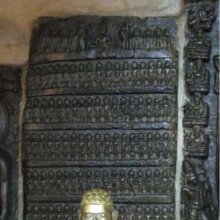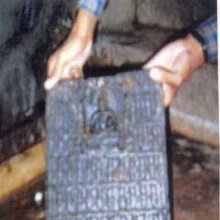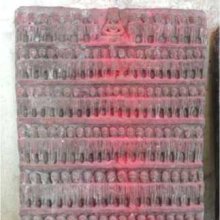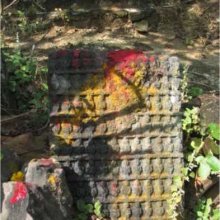Ganadhara, Gaṇadhara, Gana-dhara: 11 definitions
Introduction:
Ganadhara means something in Jainism, Prakrit, Hinduism, Sanskrit, the history of ancient India. If you want to know the exact meaning, history, etymology or English translation of this term then check out the descriptions on this page. Add your comment or reference to a book if you want to contribute to this summary article.
Images (photo gallery)
In Jainism
General definition (in Jainism)
Source: archive.org: The Jaina IconographyGaṇadhara (गणधर) refers the “attendants of a Tīrthaṃkaras” commonly found in Jaina iconography.—Another feature of the Jina icon is the presence of Gaṇadharas just to the right and left of the main figure. Jaina texts (specially of iconography) mention them as attendants of a Tīrthaṃkara. Such figures are represented as holding some Chowris, one of them might be shown with its hands elapsed in adoration.Though Yakṣa figures arc absent from the early Jina images of Mathura, Gaṇadhara figures are prominent by their presence in many of these images.
Source: HereNow4u: Lord Śrī MahāvīraGaṇadhara (गणधर) refers to a “group-leader”, a primary disciple of a Tīrthaṅkara.—Śramaṇa Lord Mahāvīra’s congregation had 11 gaṇadharas. All these were Brahmin householders from different places. On the invitation of Madhyamapāvā’s Somila all these people had come with their respective disciples to attend the sacrificial ritual. Upon attaining pure knowledge Lord Mahāvīra arrived at Pāvāpurī. All these Brahmins attended the Lord’s samavaśaraṇa along with their disciples there and impressed by his knowledge, took initiation along with their respective disciples on the 11th day of the bright fortnight of Vaiśākha month. Attaining the knowledge of the tripadīs they wrote the fourteen pūrvas and became gaṇadharas.
The gaṇadharas of Mahāvīra were:
- Indrabhūti
- Agnibhūti
- Vāyubhūti
- Ārya Vyakta
- Sudharmā
- Maṇḍita
- Mauryaputra
- Akampita
- Acalabhrātā
- Metārya
- Prabhāsa
All these gaṇadharas were Brahmins by caste and Vedic scholars. After taking initiation, they all studied the 11 Aṅgas. Hence, all of them had the knowledge of the 14 pūrvas and possessed special attainments (labdhis).
Source: OpenEdition books: VividhatīrthakalpaḥGaṇadhara (गणधर) refers to one “in charge of the troops” (i.e., a title given to the disciples to whom Mahāvīra had entrusted the charge of the troops), and represents a Jaina technical term mentioned in the Vividhatīrthakalpa by Jinaprabhasūri (13th century A.D.): an ancient text devoted to various Jaina holy places (tīrthas).—The Gaṇadhara is in charge of the education of nuns and by extension that of monks. The title is often interchanged with that of Ācārya “master” (Caillat 1965 p. 65).

Jainism is an Indian religion of Dharma whose doctrine revolves around harmlessness (ahimsa) towards every living being. The two major branches (Digambara and Svetambara) of Jainism stimulate self-control (or, shramana, ‘self-reliance’) and spiritual development through a path of peace for the soul to progess to the ultimate goal.
India history and geography
Source: Cologne Digital Sanskrit Dictionaries: Indian Epigraphical GlossaryGaṇadhara.—(HA), chief disciple of a Jina. Note: gaṇadhara is defined in the “Indian epigraphical glossary” as it can be found on ancient inscriptions commonly written in Sanskrit, Prakrit or Dravidian languages.

The history of India traces the identification of countries, villages, towns and other regions of India, as well as mythology, zoology, royal dynasties, rulers, tribes, local festivities and traditions and regional languages. Ancient India enjoyed religious freedom and encourages the path of Dharma, a concept common to Buddhism, Hinduism, and Jainism.
Languages of India and abroad
Sanskrit dictionary
Source: DDSA: The practical Sanskrit-English dictionaryGaṇadhara (गणधर).—
1) the head of a class or number.
2) the teacher of a school.
Derivable forms: gaṇadharaḥ (गणधरः).
Gaṇadhara is a Sanskrit compound consisting of the terms gaṇa and dhara (धर).
Source: Cologne Digital Sanskrit Dictionaries: Shabda-Sagara Sanskrit-English DictionaryGaṇadhara (गणधर).—m.
(-raḥ) 1. The head of a class or number, the teacher of a school. 2. A title of the first diciples of the Jaina Mahavira. E. gaṇa a class, and dhara who holds.
Source: Cologne Digital Sanskrit Dictionaries: Monier-Williams Sanskrit-English DictionaryGaṇadhara (गणधर):—[=gaṇa-dhara] [from gaṇa > gaṇ] m. the head of an assemblage of Ṛṣis under the Arhat Mahā-vīra, [Jaina literature]
Source: Cologne Digital Sanskrit Dictionaries: Yates Sanskrit-English DictionaryGaṇadhara (गणधर):—[gaṇa-dhara] (raḥ) 1. m. A teacher.
[Sanskrit to German]
Sanskrit, also spelled संस्कृतम् (saṃskṛtam), is an ancient language of India commonly seen as the grandmother of the Indo-European language family (even English!). Closely allied with Prakrit and Pali, Sanskrit is more exhaustive in both grammar and terms and has the most extensive collection of literature in the world, greatly surpassing its sister-languages Greek and Latin.
Kannada-English dictionary
Source: Alar: Kannada-English corpusGaṇadhara (ಗಣಧರ):—[noun] (Jain.) a student who has accurate knowledge of Jaina philosophy.
Kannada is a Dravidian language (as opposed to the Indo-European language family) mainly spoken in the southwestern region of India.
See also (Relevant definitions)
Full-text (+81): Shubhadatta, Ganabhrit, Agnibhuti, Kampilapura, Soma, Mahendra, Vijaya, Akampita, Jaya, Varisena, Ashramapada, Kanakaketu, Shantimati, Mithila, Yashodhara, Sambhuta, Lilavati, Dhanya, Kshemapuri, Namiraja.
Relevant text
Search found 9 books and stories containing Ganadhara, Gaṇadhara, Gana-dhara, Gaṇa-dhara; (plurals include: Ganadharas, Gaṇadharas, dharas). You can also click to the full overview containing English textual excerpts. Below are direct links for the most relevant articles:
Jainism in Odisha (Orissa) (by Ashis Ranjan Sahoo)
Jaina Antiquities at Panchagaon (Khordha) < [Chapter 3: Survey of Jaina Antiquities in Odisha]
Jaina Antiquities at Koisali (Mayurbhanj) < [Chapter 3: Survey of Jaina Antiquities in Odisha]
Jaina Antiquities at Mangala Temple, Kuansa < [Chapter 3: Survey of Jaina Antiquities in Odisha]
Trishashti Shalaka Purusha Caritra (by Helen M. Johnson)
Part 15: The foundation of the tīrtha < [Chapter III]
Part 14: Seventh incarnation as Śaṅkha < [Chapter I - Previous incarnations of Ariṣṭanemi (Nemi)]
Part 5: Founding of Mahāvīra’s congregation and gaṇas < [Chapter V - Mahāvīra’s omniscience and the originating of the fourfold congregation]
Jainism and Patanjali Yoga (Comparative Study) (by Deepak bagadia)
Part 5 - Jain scriptures and Spiritual teachers < [Chapter 3 - Jain Philosophy and Practice]
Part 5.1 - The main Twelve Angas < [Chapter 3 - Jain Philosophy and Practice]
Part 6 - Literature (comparing Yoga and Jainism < [Chapter 4 - A Comparative Study]
Bhagavati-sutra (Viyaha-pannatti) (by K. C. Lalwani)
Part 8 - On knowing by the monks < [Chapter 4]
Part 1 - Obeisances < [Chapter 1]
Kalpa-sutra (Lives of the Jinas) (by Hermann Jacobi)
Tattvartha Sutra (with commentary) (by Vijay K. Jain)
Verse 6.13 - The nature of Faith-deluding Karmas < [Chapter 6 - Influx of Karmas]
Verse 1.20 - Scriptural knowledge (śrutajñāna) < [Chapter 1 - Right Faith and Knowledge]



